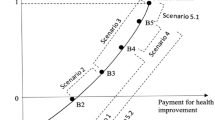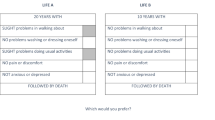Abstract
Background
Recent research suggests that the value of health states may depend on their duration, implying a more complex relationship between quality and quantity of life than the standard linear relationship assumed in the quality-adjusted life years (QALY) model.
Objective
This study models how duration affects the value of health states, using discrete choice data.
Methods
A study was conducted comprising health profiles including various durations. Health states were described with the EQ-5D. Duration was introduced as a sixth domain with six levels (1, 5, 10, 15, 30, 50 years). Sixty pairs of health profiles were selected, applying a Bayesian approach. Two hundred eight university students self-completed the computerized response tasks. Data were analyzed with a conditional logistic regression model.
Results
There is clear evidence for non-linear values for duration, that is, preferences for duration are more accurately described by a logarithmic function.
Conclusions
In discrete choice experiments using health states with different durations, these data present the first evidence for decreasing marginal utility for duration. Our results suggest that refinement of the standard QALY framework may be needed for states with a long duration.


Similar content being viewed by others
References
Fanshel, S., Bush, J.W.: A health-status index and its application to health-services outcomes. Oper. Res. 18, 1021–1066 (1970)
Sackett, D.L., Torrance, G.W.: The utility of different health states as perceived by the general public. J. Chronic. Dis. 31, 697–704 (1978)
Pliskin, J.S., Shepard, D.S., Weinstein, M.C.: Utility functions for life years and health status. Oper. Res. 28, 206–224 (1980)
Stalmeier, P.F.M., Wakker, P.P., Bezembinder, T.G.G.: Preference reversals: violations of unidimensional procedure invariance. J. Experimental Psychology-Human Percept. Perform. 23(4), 1196–1205 (1997)
Krabbe, P.F.M., Bonsel, G.J.: Sequence effects; health profiles, and the QALY model. In search of realistic modeling. Med. Decis. Mak. 18, 178–188 (1998)
Dolan, P., Stalmeier, P.: The validity of time trade-off values in calculating QALYs: constant proportional time trade-off versus the proportional heuristic. J. Health Economics 22(3), 445–458 (2003)
Spencer, A.: A test of the QALY model when health varies over time. Soc. Sci. Med. 57, 1697–1706 (2003)
Ryan, M., Gerard, K., Amaya-Amaya, M. (eds.) Using Discrete Choice Experiments to Value Health and Health Care. Springer, Berlin (2008)
Hakim, Z., Pathak, D.S.: Modelling the Euroqol data: a comparison of discrete choice conjoint and conditional preference modelling. Health. Econ. 8, 103–116 (1999)
Szeinbach, S.L., Barnes, J.H., McGhan, W.F., et al.: Using conjoint analysis to evaluate health state preferences. Drug. Inf. J. 33, 849–858 (1999)
McKenzie, L., Cairns, J., Osman, L.: Symptom-based outcome measures for asthma: the use of discrete choice methods to assess patient preferences. Health. Policy. 57, 193–204 (2001)
McCabe, C., Brazier, J., Gilks, P., et al.: Using rank data to estimate health state utility models. J. Health. Econ. 25, 418–431 (2006)
Ratcliffe, J., Brazier, J., Tsuchiya, A., et al.: Using DCE and ranking data to estimate cardinal values for health states for deriving a preference-based single index from the sexual quality of life questionnaire. Health. Econ. 18, 1261–1276 (2009)
Stolk, E., Oppe, M., Scalone, L., Krabbe, P.F.M.: Discrete choice modeling for the quantification of health states: the case of the EQ-5D. Value in Health. 13(8), 1005–1013 (2010)
Brazier, J., Rowen, D., Yang, Y., Tsuchiya, A.: Comparison of health state utility values derived using time trade-off, rank and discrete choice data anchored on the full health-dead scale. Eur. J. Health. Econ. 13(5), 575–587 (2012)
Bansback, N., Brazier, J., Tsuchiya, A., Anis, A.: Using a discrete choice experiment to estimate health state utility values. J. Health. Econ. 31(1), 306–318 (2012)
Rabin, R., de Charro, F.: EQ-5D: a measure of health status from the EuroQol Group. Ann. Med. 33, 337–343 (2001)
Rose, J.M., Bliemer, M.C.J.: Stated preference experimental design strategies. In: Hensher, D.A., Button, K. (eds.) Transport modeling (2nd ed.). Handbooks in transport, 1st edn. Elsevier, Oxford (2007)
Shaw, J.W., Johnson, J.A., Coons, S.J.: US valuation of the EQ-5D health states: development and testing of the D1 valuation model. Med. Care. 43, 203–220 (2005)
Lamers, L.M., McDonnell, J., Stalmeier, P.F.M., et al.: The Dutch tariff: results and arguments for an effective design for national EQ-5D valuation studies. Health. Econ. 15, 1121–1132 (2006)
Dolan, P.: Modeling valuations for the EuroQoL health states. Med. Care. 35, 1095–1108 (1997)
Huber, W., Zwerina, K.: The importance of utility balance in efficient choice designs. J Marketing Research. 33, 307–317 (1996)
Louviere, J.J., Hensher, D.A., Swait, J.D.: Stated choice methods: analysis and application. Cambridge University Press, Cambridge (2000)
Manski, C.: The structure of random utility models. Theor. Decis. 8, 229–254 (1977)
Train, K.E.: Discrete choice methods with simulation. Cambridge University Press, Cambridge (2003)
Sutherland, H.J., Llewellyn-Thomas, H., Boyd, N.F., Till, J.E.: Attitudes towards quality of survival: the concept of maximum endurable time. Med. Decis. Making. 2, 299–309 (1982)
Stalmeier, P.F.M., Chapman, G.B., de Boer, A.G.E.M., et al.: A fallacy of the multiplicative QALY model for low quality weights in students and patients judging hypothetical health states. Int. J. Technol. Assess. Health. Care. 17, 488–496 (2001)
Robinson, A., Spencer, A.: Exploring challenges to TTO utilities: valuing states worse than dead. Health. Econ. 15, 393–402 (2006)
Stalmeier, P.F.M., Lamers, L.M., Busschbach, J.J.V., Krabbe, P.F.M.: On the assessment of preferences for health and duration maximal endurable time and better than dead preferences. Med. Care. 45, 835–841 (2007)
Loewenstein, G.F., Prelec, D.: Preferences for sequences of outcomes. Psychol. Rev. 100(1), 91–108 (1993)
van der Pol, M., Cairns, J.: Estimating time preferences for health using discrete choice experiments. Soc. Sci. Med. 52, 1459–1470 (2001)
Acknowledgments
This work was partially based on our inspiring discussions and reflections during several meetings of the EuroQol Valuation Task Force. Therefore, we wish to express our thanks in particular to Frank de Charro, Nancy Devlin, Ben van Hout, Paul Kind, and David Parkin. A special thank you to Elly Stolk and Mark Oppe for their precious contributions to the study design and data collection. We thank also Eva de Vries, Anke Naaborgh, and Mark Huijsman for their assistance in the data collection, and Roberta Ciampichini for her assistance in data management. Everyone who contributed significantly to the work has been listed in the acknowledgements. This research was made possible by a grant provided by the EuroQoL Group. It was presented at the ISPOR 13th Annual European Congress in Prague, November 2010, and was a candidate for receiving the best poster research presentation award.
Conflict of interest
The authors of this manuscript have no conflict of interest to declare.
Author information
Authors and Affiliations
Corresponding author
Rights and permissions
About this article
Cite this article
Scalone, L., Stalmeier, P.F.M., Milani, S. et al. Values for health states with different life durations. Eur J Health Econ 16, 917–925 (2015). https://doi.org/10.1007/s10198-014-0634-0
Received:
Accepted:
Published:
Issue Date:
DOI: https://doi.org/10.1007/s10198-014-0634-0




